Cellular membranes are fluid mosaics of what?
Lipids and proteins
What are the must abundant lipids in the plasma membrane?
Phospholipids
What does amphipathic mean?
having both a hydrophobic and hydrophillic region.
What does a phospholipid bilayer do?
creates a stable boundary between 2 aqueous compartments
Describe a phospholipid
hydrophilic head and hydrophobic tail
What role does cholesterol play on the movement of phospholipids?
It lowers it movement
What are the 2 types of membrane proteins?
Peripheral(outside the cell membrane) and integral(inside the cell membrane)
What is a glycoprotein?
are proteins and carbs covalently bonded. They help with a variety of functions.
What is a gylcolipid?
are lipids and carbs covalently bonded. Help maintain the stability of the cell and facilitate cellular recognition.
What controls how the cell exchanges materials with its surroundings?
Plasma membrane
What permeability are plasma membranes?
Selectively permeable
What are transport proteins?
they allow passage of hydrophilic substances across the membrane
What do channel proteins called aquaporins do?
facilitate the passage of water
What does a carrier protein do?
they bind to molecules and change shape to shuttle them across the membrane
Know the types of membrane transport.
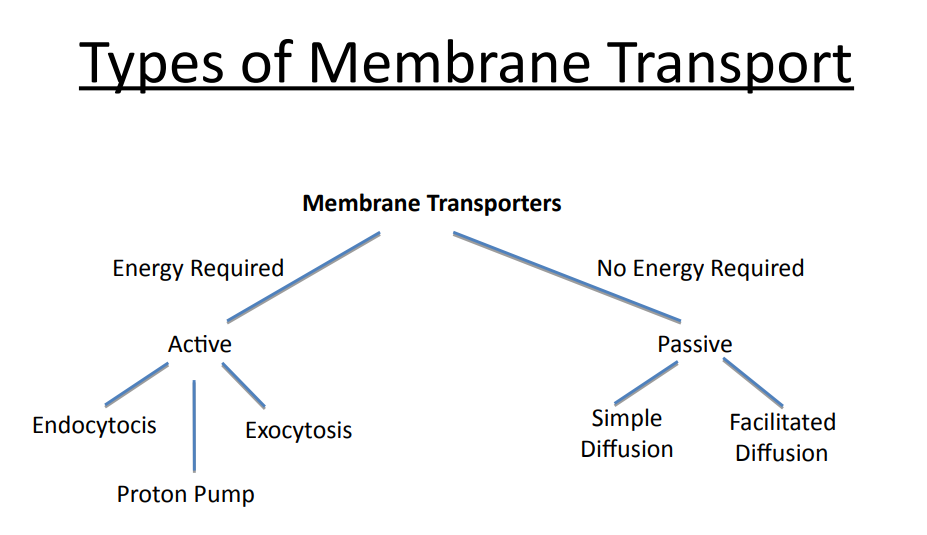
Active vs passive
What is osmosis?
the diffusion of water across a selectively permeable membrane. Water diffuses from low to high concentrations.
What is isotonic, hypertonic, and hypotonic
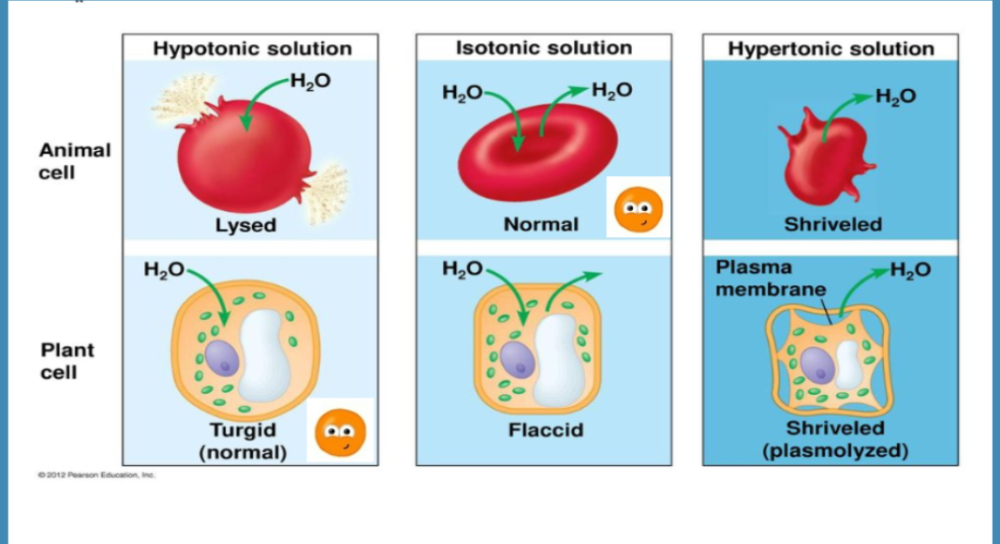
isotonic - no net water movement
hypertonic - water leaves the cell
hypotonic - water comes into the cell
What is tonicity?
the ability of a surrounding solution to cause a cell to gain or lose water
What is osmoregulation?
the control of solute concentrations and water balance
Active transport requires energy from what?
ATP
The sodium postassium pump is a type of what transport?
Active transport
What is exocytosis?
transport vesicles migrate to the membrane, fuse with it, and release their contents outside the cell
What is endocytosis?
the cell takes in macromolecules by forming vesicles from the plasma membrane
What are the 3 types of endocytosis?
1. Phagocytosis (“cellular eating”)
2. Pinocytosis (“cellular
drinking”) Receptor-mediated
3.endocytosis
What is metabolism?
the chemical process in the cells of living organisms that allow them to convert food and drink into energy and waste
What is a catabolic pathway?
release energy by breaking down complex molecules into simpler compounds
What is an anabolic pathway?
consume energy to build complex molecules from simpler ones
What are some of the forms of energy?
Kinetic, heat(thermal), potential, and chemical
What is thermodynamics?
The study of energy transformation
What is the first law of thermodynamics?
Energy can be transferred and transformed, but it cannot be created or destroyed
What is the second law of thermodynamics?
Every energy transfer or transformation increases the entropy (disorder) of the universe
What is entrophy?
The measure of disorder
What does the free energy of reactions tell us?
If the reaction is spontaneous
What does spontaneous mean?
energetically favorable
What is the equation for Gibbs free energy?
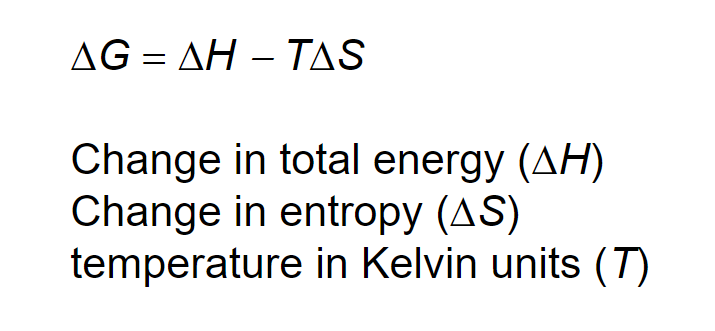
energy that can do work when temperature and pressure are uniform
What is a exogenic reaction?
proceeds with a net release of free energy and is spontaneous
What is endogenic reaction?
absorbs free energy from its surroundings and is nonspontaneous
When a reaction equals equilibrium will they do work?
No
What are the 3 main kinds of work that a cell does?
Chemical, transport, mechanical
What is ATP made of?
3 phosphate groups, adenine, and ribose
How does ATP regenerate?
The ATP cycle is a revolving door through which energy passes during its transfer from catabolic to anabolic pathways. (Goes from ATP to ADP)
What is a catalyst?
chemical agent that speeds up a reaction without being consumed by the reaction
What is an enzyme?
A catalytic protein that lowers activation energy
What is the reactant that an enzyme act on?
substrate
How is an enzyme substrate complex formed?
when an enzyme binds to its substrate
What are cofactors?
they are non-protein enzyme helpers
What is an organic cofactor called?
coenzyme
What are competitive inhibitors?
they bind to the active site of an enzyme, competing with the substrate
What are noncompetitive inhibitors?
bind to another part of an enzyme, causing the enzyme to change shape and making the active site less effective
What is allosteric regulation?
occurs when a regulatory molecule binds to a protein at one site and affects the protein’s function at another site
What is cooperativity?
a form of allosteric regulation that can amplify enzyme activity
What are some functions of membrane proteins?
cell-cell recognition, intercellular joining, enzymatic activity, and transport
Where are carbs found in the fluid mosiac model of the plasma membrane?
On the outside surface of the membrane.
Where is cholesterol found in the fluid mosiac model of the plasma membrane?
The interior of the membrane
Describe passive transport.
permits the solute to move in either direction, but the net movement of solute molecules occurs down the concentration gradient of the molecule.
Does facilitated diffusion need energy (ATP)?
No
What do electrogenic pumps do?
Create a voltage difference across the membrane
Know the fluid mosaic model.
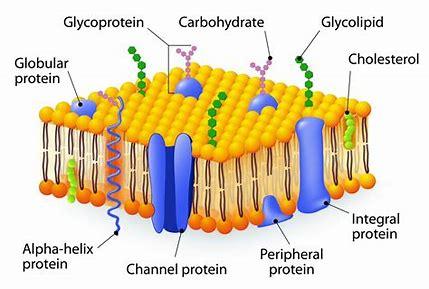
Simple vs facilitated diffusion.
Simple moves small, non polar molecules
Know the gibbs free energy equation and what they mean.
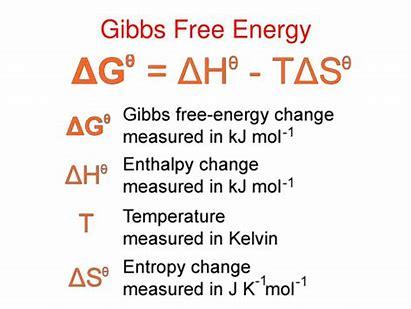
Does the sign and magnitude of the ΔG of a reaction tell us about the speed of the reaction?
No, it has nothing to do with the speed of the reaction
The majority of spontaneous reactions ________ the entropy of the system.
increase
What does photosynthesis do?
converts the energy of sunlight into chemical energy stored in sugars.
What are the differences between autotrophs and heterotrophs
autotrophs produce their own food form co2 while heterotrophs are unable to make their own food and live on compounds produced by others.
Where does photosynthesis occur?
In the chloroplast organelles containing thylakoids
What is the photosynthesis equation
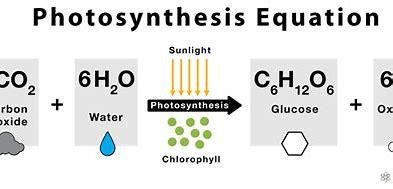
Why is photosynthesis know as a redox reaction?
Because H2O is oxidized and CO2 is reduced
Explain the light reaction that happens in photosynthesis
the thylakoid membranes split water, releasing O2, producing ATP, and forming NADPH.
Explain the dark reaction (calvin cycle) that happens in photosynthesis
in the stroma forms sugar from CO2, using ATP for energy and NADPH for reducing power.
Photosystem II contains what chlorophyll a molecule
P680
Photosystem I contains what chlorophyll a molecule
P700
What comes first photosystem I or II
Photosystem II
What are the 3 steps of the calvin cycle?
1. carbon fixation
2. Reduction
3. Regeneration of CO2 acceptor
How does CO2 enter the plant
Through the stoma
What is the role of NADP+ in photosynthesis?
It forms NADPH to be used in the calvin cycle
What does pigments do in photosynthesis
Capture light energy
Where do the electrons entering photosystem II come from?
water
Know the model for photosynthesis
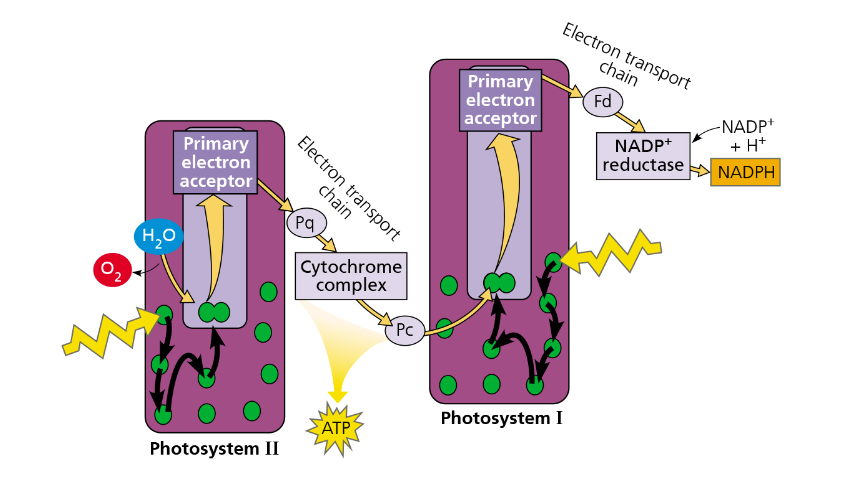
Both mitochondria and chloroplasts
use chemiosmosis to produce atp
What is the role of NADP+ in photosynthesis?
It is reduced then carries electrons to the calvin cycle
Which of the following occurs during the Calvin cycle?
ATP is hydrolyzed and NADPH is reduced and CO2 is reduced
What is rubisco?
the enzyme in plants that captures CO2 to begin the Calvin cycle
What are the correct order of the three phases of Calvin cycle.
Carbon fixation → Glyceraldehyde-3-Phosphate synthesis → Ribulose BisPhosphate regeneration
What is the cell signaling pathway
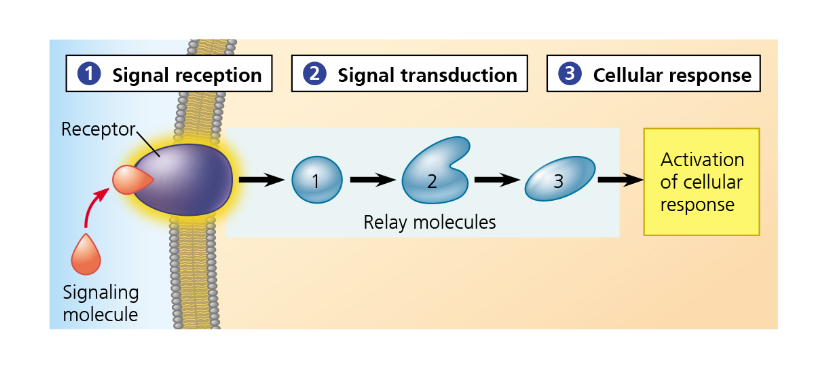
1. Signal reception
2. Signal transduction
3. Cellular response
What are the 3 major types of cell recptors?
G protein coupled receptors, Receptor tyrosine kinase, and Ligand gated ion channels
Compare fermentation to cellular respiration?
Fermentation is a process that results in the partial degradation of glucose without the use of oxygen O2. The process of cellular respiration is a more complete breakdown of glucose.
What is oxidation?
The total or partial loss of electrons
What is reduction?
The total or partial addition of electrons
What are the 3 stages of aerobic respiration?
1. glycosis
2. pyruvate oxidation and the citric acid cycle
3. oxidative phosphorylation
Describe the first step of glycosis.
glucose is broken down into 2 pyruvate molecules and s net ATP/ 2 NADH.
Describe the citric acid cycle.
pyruvate enters the mitochondrion and is oxidized to acetyl CoA.
-ATP, CO2, NADH, and FADH2 is outputted.
Describe the electron transport chain?
NADH and FADH2 transfer electrons to the electron transport chain. Electrons move down the chain, losing energy in several energy-releasing steps. Finally, electrons are passed to O2, reducing it to H2O.
About how many ATP are produced after the electron transport chain?
32
What are the 2 common types of fermentation
alcohol fermentation and lactic acid fermentation.
Most of the ATP produced in cellular respiration comes from which of the following processes?
Oxidative phosphorylation
Where do the reactions of glycolysis occur in a eukaryotic cell?
The cytosol
What are the products of glycosis?
pyruvate, ATP and NADH
Arrange the following stages of cellular respiration from the lowest to the highest on the basis of the total amount of ATP produced per molecule of glucose.
Pyruvic acid oxidation, Krebs cycle, Glycolysis, Oxidative phosphorylation
Which of the following molecules in the process of glycolysis possesses the most chemical energy?
Fructose-1,6-bisphosphate